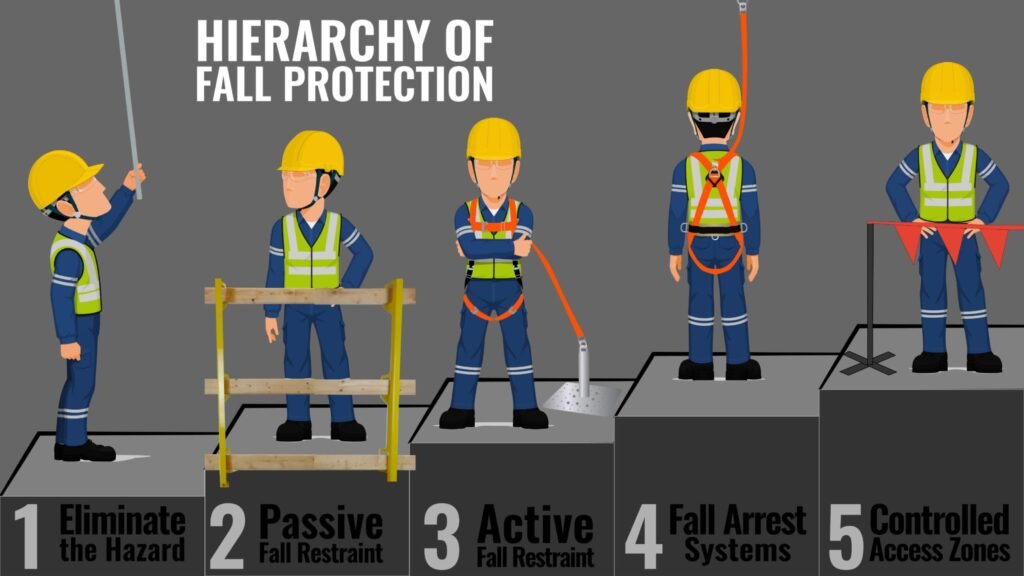Protecting Workers After Falling from Heights: Comprehensive Safety Measures
5 min readFalls from heights are one of the leading causes of workplace injuries and fatalities. According to the Occupational Safety and Health Administration (OSHA), falls account for a significant number of preventable accidents in various industries. As an employer or safety professional, it is crucial to prioritize the safety of workers who perform tasks at elevated heights. In this article, we will explore comprehensive safety measures to protect workers after falling from heights, including risk assessment, fall protection systems, training and education, and ongoing monitoring and evaluation.
Also Read: Guideline for Process Safety Management Program with Free Training

Understanding the Risks
Importance of risk assessment
Before implementing safety measures, it is essential to conduct a thorough risk assessment. A risk assessment helps identify potential hazards and determine the appropriate safety measures to mitigate them effectively. It involves evaluating the tasks performed at heights, identifying potential fall hazards, and assessing the likelihood and severity of accidents.
Common hazards associated with falls from heights
Several factors contribute to falls from heights, including unstable working surfaces, lack of fall protection equipment, inadequate training, and human error. Some common hazards that workers may encounter include unprotected edges, unguarded openings, slippery surfaces, inadequate scaffolding, and improper use of ladders.
Fall Protection Systems
Hierarchy of Fall Protection
To protect workers after falling from heights, it is crucial to follow the hierarchy of fall protection. This hierarchy prioritizes the most effective and reliable methods for preventing falls. The hierarchy includes four levels: elimination, prevention, arrest, and administrative controls.


Elimination and prevention measures
Elimination and prevention measures involve eliminating the need for workers to perform tasks at heights or reducing the risks associated with such tasks. This can be achieved through engineering controls, such as the installation of guardrails, barriers, or nets to prevent falls. Other prevention measures include using aerial lifts or platforms instead of ladders, providing stable and well-maintained working surfaces, and implementing proper housekeeping practices to minimize slip and trip hazards.
Fall arrest systems
Fall arrest systems are designed to minimize the impact of a fall and prevent workers from hitting the ground or other objects. These systems typically consist of a full-body harness, a connecting device (such as a lanyard or self-retracting lifeline), and an anchor point capable of supporting the worker’s weight. Fall arrest systems should be properly inspected, maintained, and used in accordance with manufacturer guidelines and OSHA regulations. ( Also Read: Photo of the day: 8 Basic steps to wear a safety harness )
Administrative controls
Administrative controls involve implementing policies, procedures, and training programs to reduce the risk of falls. This includes developing a comprehensive fall protection plan, conducting regular safety meetings, providing training on fall hazards and prevention methods, and ensuring proper communication and supervision on worksites.
Training and Education
Importance of training
Proper training and education play a vital role in protecting workers after falling from heights. Workers should receive training on fall hazards, safe work practices, and the correct use of fall protection equipment. Training should be provided to all workers who perform tasks at heights, including supervisors, contractors, and temporary workers.
Also Read: The importance of HSE training for employees in all industries
Key components of fall protection training
Fall protection training should cover several key components to ensure workers are well-equipped to work safely at heights. These components include:
- Hazard recognition: Workers should be trained to identify potential fall hazards and understand the importance of maintaining a safe working environment.
- Proper use of equipment: Training should focus on the correct use, inspection, and maintenance of fall protection equipment, including harnesses, lanyards, and anchor points.
- Emergency procedures: Workers should be trained on emergency response procedures in the event of a fall, including rescue techniques and first aid.
- Ongoing education: Regular refresher training should be provided to reinforce knowledge and address any updates or changes in safety regulations or equipment.
Training resources and certifications
Various resources and certifications are available to support fall protection training efforts. Organizations such as OSHA offer online courses, webinars, and publications related to fall protection. Additionally, there are industry-specific training programs and certifications, such as the Certified Fall Protection Professional (CFPP) certification, which validates an individual’s expertise in fall protection systems.
Photo of the day: DO’S and DON’TS of Working At Heights
Ongoing Monitoring and Evaluation
Importance of ongoing monitoring
Once safety measures are implemented, it is crucial to continuously monitor and evaluate their effectiveness. Ongoing monitoring helps identify potential hazards, assess the performance of fall protection systems, and determine areas for improvement.
Regular inspections and maintenance
Regular inspections of fall protection equipment and systems are essential to ensure their proper functioning. Equipment should be inspected before each use, and formal inspections should be conducted at regular intervals by qualified personnel. Any damaged or malfunctioning equipment should be immediately repaired or replaced.
Also Read: Workplace inspections(Opens in a new browser tab)
Incident reporting and investigation
In the event of a fall or near-miss incident, it is important to have a thorough incident reporting and investigation process in place. This allows for the identification of underlying causes, the implementation of corrective actions, and the prevention of similar incidents in the future. Workers should be encouraged to report any incidents or hazards they encounter, and a culture of safety should be fostered where reporting is encouraged and prioritized.
Data analysis and trend identification
Analyzing incident data and trends can provide valuable insights into the effectiveness of safety measures and help identify areas for improvement. By tracking and analyzing data related to falls from heights, patterns or recurring issues can be identified, allowing for targeted interventions and improvements in safety protocols.
Also Read E-Books: Changing the Workplace Safety Culture free download
Protecting workers after falling from heights requires a comprehensive approach that includes risk assessment, fall protection systems, training and education, and ongoing monitoring and evaluation. By implementing these safety measures, employers and safety professionals can create a work environment that prioritizes worker safety and reduces the risks associated with falls from heights. Remember, the well-being and safety of workers should always be the top priority in any workplace.
Read Also: Photo of the day: Outline Safety observations
For more safety Resources Please Visit Safetybagresources



